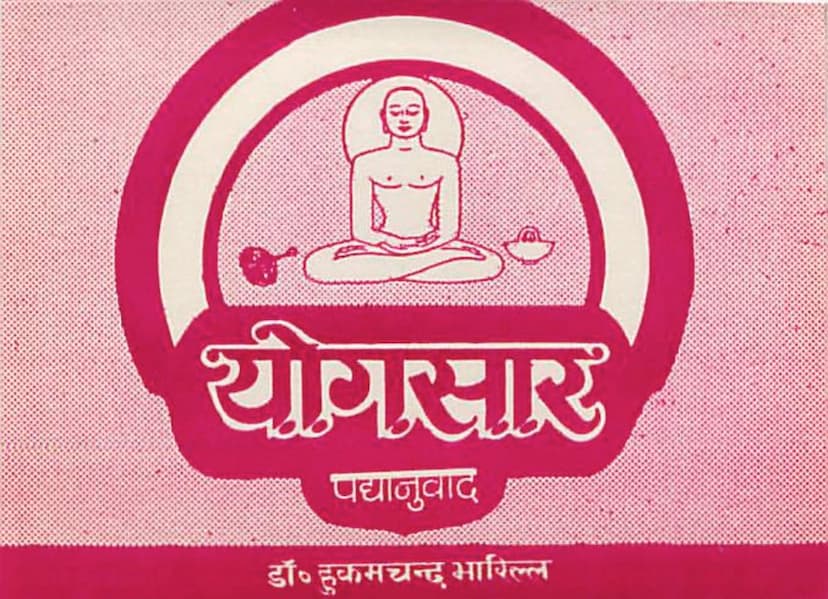Yogsara Padyanuwad
Added to library: September 2, 2025

Summary
This is a comprehensive summary of the Jain text "Yogsara Padyanuwad" by Hukamchand Bharilla, a Hindi poetic translation of the original Yogsaar by Joindu Muni:
Title: Yogsara Padyanuwad (Poetic Translation of Yogsaar) Author (Translation): Dr. Hukamchand Bharilla Original Author: Joindu Muni Publisher: Pandit Todarmal Smarak Trust, Jaipur
Overall Theme: The book, "Yogsara Padyanuwad," is a poetic rendition in Hindi of the profound spiritual teachings of Joindu Muni's "Yogsaar." The central theme revolves around the realization and attainment of the true, pure soul (Atma) as the sole path to liberation (Moksha). It emphasizes that true spirituality lies not in external rituals or attachments, but in the internal understanding and unwavering focus on the self.
Key Teachings and Concepts:
- The True Nature of the Soul (Atma): The text repeatedly asserts that the soul is inherently pure, eternal, omniscient, and blissful. It is the Atma that is the ultimate reality, and all other perceived realities are secondary or illusory.
- Liberation (Moksha) through Self-Realization: The primary message is that liberation from the cycle of birth and death (Samsara) is achieved solely through the direct knowledge and realization of the Atma. No external factors, rituals, or even virtuous deeds alone can lead to Moksha if the self is not understood.
- Distinguishing the Self from the Non-Self: A crucial aspect is the ability to differentiate between the soul (Atma) and everything else that is not the soul (non-Atma), including the body, senses, emotions, and external objects. Attachment to the non-self is the root cause of suffering and bondage.
- The Illusion of External Devotion: The text criticizes the misconception that God or spiritual fulfillment is found in external temples, idols, or rituals. It asserts that the true "temple" of the divine is within one's own body and soul. The divine presence resides within.
- The Importance of Inner Experience over External Practices: While external practices like vows, austerities, and moral conduct are mentioned as part of the conventional path (Vyavahar), they are ultimately considered effective only when they lead to the realization of the Atma. Without self-knowledge, these practices are incomplete.
- The Nature of Bondage and Liberation: Bondage is described as being caused by attachment to external states and ignorance of the true self. Liberation, conversely, is the detachment from these external states and the firm establishment in the consciousness of the pure soul.
- The Equality of All Liberated Souls: The text highlights that the qualities of all liberated beings (Siddhas, Arhats, etc.) are ultimately the same – they are all pure, omniscient souls. There is no fundamental difference between them and one's own potential pure soul.
- The Role of Right Faith (Samyaktva): Right faith, characterized by the accurate knowledge of the soul and the universe, is presented as paramount and the gateway to all other spiritual attainments, including omniscience and eternal happiness.
- The Transitory Nature of Karmic Influences: While karma is acknowledged as the cause of worldly experiences, the text emphasizes that the dissolution of karma occurs through the unwavering realization of the Atma.
- The Concept of Equanimity (Samabhava): The state of equanimity, free from attachment and aversion (Samayika), is described as the true spiritual practice that leads to liberation. This state is achieved by relinquishing passions like anger, pride, deceit, and greed.
- The Inner Search: The book repeatedly urges the seeker to look within, to meditate on the Atma, and to realize that all spiritual power and fulfillment are already present within.
- The Uniqueness of the Soul: The soul is described as being unique, formless, and possessing infinite attributes. The journey is about recognizing this inherent nature.
Structure and Style: The book is a poetic translation, likely using meters like Hari Geet, which makes the profound philosophical concepts accessible and engaging. It presents its teachings through verses, each conveying a specific spiritual insight or directive.
Key Takeaway: "Yogsara Padyanuwad" is a profound guide for spiritual seekers, unequivocally stating that the path to liberation lies in understanding, experiencing, and merging with one's own true, divine, and pure soul. It calls for an internal revolution, a shift in focus from the external world to the inner self, as the ultimate solution to suffering and the attainment of eternal bliss.